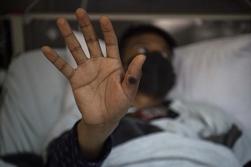 A patient shows his hand with a sore caused by an infection of the monkeypox virus, in the isolation area for monkeypox patients at the Arzobispo Loayza hospital, in Lima on Aug 16, 2022. Nearly 28,000 cases have been confirmed worldwide in the last three months and the first deaths are starting to be recorded. (ERNESTO BENAVIDES / AFP)
A patient shows his hand with a sore caused by an infection of the monkeypox virus, in the isolation area for monkeypox patients at the Arzobispo Loayza hospital, in Lima on Aug 16, 2022. Nearly 28,000 cases have been confirmed worldwide in the last three months and the first deaths are starting to be recorded. (ERNESTO BENAVIDES / AFP)
GENEVA, Nov. 28 (Xinhua) -- To avoid racist stereotypes and stigmatization, the World Health Organization (WHO) recommended on Monday that the monkeypox virus be renamed "mpox."
Both names -- mpox and monkeypox -- will be used simultaneously for one year while the latter is phased out, the WHO said in a press release. The change comes after a number of individuals and countries have raised concerns in several meetings and asked the WHO to propose a way forward to change the name.
Monkeypox as PHEIC, the highest level of alert that the global health authority can issue
READ MORE: WHO: Monkeypox cases spike in Americas, fall in Europe
The one-year transition period serves to mitigate experts' concerns about confusion caused by a name change in the midst of a global outbreak. It also gives time to complete the International Classification of Diseases (ICD) update process and to update WHO publications.
READ MORE: WHO releases new global classification of diseases
In July, the WHO officially declared the multi-country monkeypox outbreak outside of the traditional endemic areas in Africa a public health emergency of international concern (PHEIC), the highest level of alert that the global health authority can issue.
It is the WHO's responsibility to assign names to new and existing diseases through a consultative process, which includes the WHO member states. The consultation on monkeypox has involved representatives from government authorities of 45 different countries, it said.
According to the WHO, as of Saturday, 110 member states had reported 81,107 laboratory confirmed cases and 1,526 probable cases, including 55 deaths. Most cases reported in the past four weeks were from the Americas (92.3 percent) and Europe (5.8 percent). The number of weekly reported new cases globally decreased by 46.1 percent in the week of Nov. 21-27.


